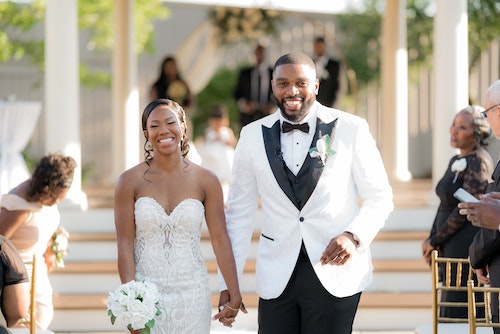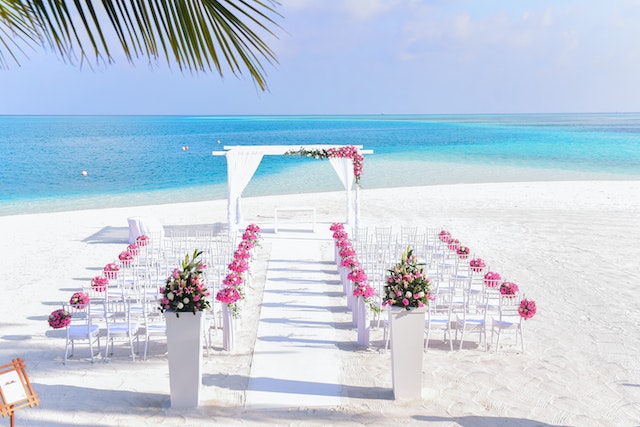A recent survey revealed that a staggering 96% of couples found wedding planning stressful. Planning a wedding can be a roller coaster ride, but there are ways to eliminate stress and ensure that the process is fun and memorable for all the right reasons. In this guide to simple, hassle-free wedding planning, we’ve put together the ultimate checklist to make life as easy as possible for couples.

Setting a budget
The first step to take when planning a wedding is to set a budget. Money is the top cause of stress for most couples. It’s no secret that weddings are expensive. The average cost of a wedding in 2022 was $30,000. Establishing a budget is essential because it enables you to assess how much you can afford to spend and then allocate funds accordingly. If your budget is tight, you can highlight areas where it’s possible to reduce spending. If you’re not overly fussed about having a formal, sit-down meal, for example, you might decide to reduce your catering budget to allow you to spend more on a venue, a photographer or entertainment. Once you know how much money you have, you can explore ideas and options that fit within your budget.
Outlining your priorities
Most couples sit down and write a huge list of tasks they need to check off a list and items they need to buy or hire. We often have a preconceived idea of what is needed to make a wedding day special, but your big day doesn’t have to be like every wedding you’ve seen in the movies or on TV. You might not want a huge party, a formal feast or a designer ivory gown, for example. Outline your priorities and establish what matters most to you. Perhaps you want to splash out on top-rated wedding DJs to host a memorable party, you’re keen to hire the best photographer in the area, or you dream of tying the knot in an incredible location. Focus on checking off the priority jobs and then turn your attention to the tasks that aren’t quite as important.
Finding a venue
For many people, choosing a wedding venue is one of the most exciting elements of planning their wedding. Today, there’s a hugely diverse range of options available, and it’s worth taking the time to explore different locations and destinations and see what kind of venue appeals most to you. From religious buildings, country estates, ranches, parks and castles to beaches, hotels and restaurants, there’s something for everyone.
Consider the type of wedding you want to plan. Do you long for a traditional, rustic country wedding? Do you love the idea of saying your vows on the roof of a luxury hotel overlooking the city? Are you conjuring up ideas of a laid-back festival wedding, or does the prospect of jetting off to an exotic resort and saying ‘I do’ with sand between your toes sound like a dream? Think about your budget, your party size and how far you want to travel and then narrow down your options. Taking virtual tours and looking at online brochures and photographs on social media can be helpful but there’s no substitute for seeing venues in the flesh. Try to arrange viewings and go back two or three times to make sure you are 100% sure.

Deciding what to wear
Buying a wedding outfit is often one of the first jobs people write on their to-do list. It’s incredibly exciting to think about what you’re going to wear on your special day. It’s beneficial to give yourself time to try outfits on and allow for alterations and modifications. If you’re buying a dress from a bridal boutique, it can take months for designers to send new gowns if the size you want isn’t in stock. It’s also helpful to have a few fittings in the run-up to the wedding. It may be possible to buy a gown off the rail, but be mindful that options may be limited.
When it comes to choosing what to wear, try not to feel pressured by others or societal norms and trends. You should feel comfortable and confident on your wedding day. You may want a traditional princess dress, but if you don’t, you shouldn’t feel that you have to walk down the aisle in one. You could go for a different cut, wear a short dress, opt for color, or choose a jumpsuit, a skirt and top or a fitted suit instead.
Setting a date and spreading the word
Giving guests plenty of notice is beneficial because people have busy schedules and they may need to make plans. If you’re getting married abroad, you’re not inviting young children to your ceremony, or most of your guests will need to find accommodation for the night, it’s wise to spread the word as soon as you have set a date. You can send an email or design an online save-the-date card to let people know so that they can put the date in their diaries. Once you have more information, you can send a more formal invitation closer to the big day with recommendations for places to stay, timings, dress codes and gift ideas.
Making bookings
Once you have identified your priorities, start researching and making bookings. Photographers, DJs, wedding bands, venues, caterers and videographers can get booked up months or even years in advance, especially during peak wedding season. If you’re getting married in the summer months, or you’re hoping to tie the knot on New Year’s Eve or a public holiday, for example, you’ll need to give yourself as much time as possible. Research online, ask friends and colleagues for recommendations, read reviews, view portfolios and get to know people before you hire companies or sign contracts. Organize meetings, calls or video chats and make a decision once you have a shortlist. Make a record of payments so that you know how much you’ve paid, how much is outstanding and when you need to complete payments.

Planning a wedding can be stressful, but it should also be fun. This is a unique experience, which should be treasured. To make life easy, follow these simple steps. Set a budget and outline your priorities. Think about what you want to wear and where you want to get married, set a date and give guests as much notice as possible. Make bookings early and keep a record of payments and payment deadlines. Customize your plans to suit your preferences and don’t sweat the small stuff.
























